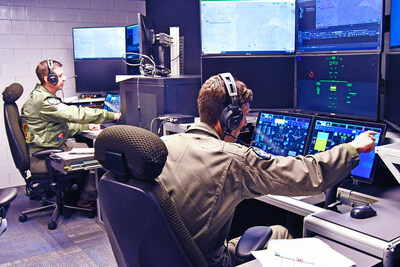U.S. Navy and Lockheed Martin Skunk Works® Demonstrate First Live Control of an Uncrewed Air Vehicle by UMCS and MDCX™
Lockheed Martin (NYSE: LMT) and the U.S. Navy achieved a significant milestone in unmanned aviation with the first-ever live control flight demonstration of an uncrewed system using the Unmanned Carrier Aviation Mission Control Station (UMCS). The demonstration involved controlling a General Atomics MQ-20 Avenger using Skunk Works® MDCX™ autonomy platform. Navy Air Vehicle Pilots in Maryland successfully controlled the MQ-20 during its flight in California, demonstrating beyond line-of-sight capabilities. This advancement supports the Navy's Carrier Air Wing of the Future vision and marks progress in developing common control architecture for crewed-uncrewed teaming programs.
Lockheed Martin (NYSE: LMT) e la Marina degli Stati Uniti hanno raggiunto un traguardo significativo nell'aviazione senza pilota con la prima dimostrazione di volo controllato in tempo reale di un sistema non pilotato utilizzando la Stazione di Controllo delle Missioni per l'Aviazione Senza Pilota (UMCS). La dimostrazione ha previsto il controllo di un General Atomics MQ-20 Avenger utilizzando la piattaforma di autonomia Skunk Works® MDCX™. I Piloti di Velivoli della Marina nel Maryland hanno controllato con successo l'MQ-20 durante il suo volo in California, dimostrando capacità di controllo oltre la linea di vista. Questo progresso sostiene la visione della Marina per il Gruppo Aereo di Portaerei del Futuro e segna un avanzamento nello sviluppo di un'architettura di controllo comune per i programmi di collaborazione tra equipaggiati e non equipaggiati.
Lockheed Martin (NYSE: LMT) y la Marina de los EE. UU. lograron un hito significativo en la aviación no tripulada con la primera demostración de vuelo controlado en vivo de un sistema no tripulado utilizando la Estación de Control de Misión de Aviación No Tripulada (UMCS). La demostración consistió en controlar un General Atomics MQ-20 Avenger utilizando la plataforma de autonomía Skunk Works® MDCX™. Pilotos de Aeronaves de la Marina en Maryland controlaron con éxito el MQ-20 durante su vuelo en California, demostrando capacidades más allá de la línea de visión. Este avance apoya la visión de la Marina para el Ala Aérea del Futuro y marca un progreso en el desarrollo de una arquitectura de control común para programas de trabajo en equipo entre tripulados y no tripulados.
록히드 마틴 (NYSE: LMT)과 미국 해군은 무인 항공 분야에서 중요한 이정표를 세웠습니다. 무인 항공 미션 제어 스테이션(UMCS)을 사용하여 최초의 실시간 제어 비행 시연을 실시했습니다. 이 시연에서는 스쿵크 웍스® MDCX™ 자율성 플랫폼을 이용해 제너럴 아토믹스 MQ-20 어벤저를 조정했습니다. 해군 항공기 조종사들이 메릴랜드에서 캘리포니아의 비행 중 MQ-20을 성공적으로 제어하여 시야를 초월한 능력을 보여주었습니다. 이 발전은 해군의 미래 항공모함 비전과 협력형 프로그램을 위한 공통 제어 아키텍처 개발의 진전을 의미합니다.
Lockheed Martin (NYSE: LMT) et la Marine américaine ont atteint un jalon significatif dans l'aviation sans pilote avec la toute première démonstration de vol contrôlé en direct d'un système sans équipage utilisant la Station de Contrôle de Mission Aviation Sans Pilote (UMCS). La démonstration a impliqué le contrôle d'un General Atomics MQ-20 Avenger en utilisant la plateforme d'autonomie Skunk Works® MDCX™. Des Pilotes de Véhicules Aériens de la Marine dans le Maryland ont contrôlé avec succès le MQ-20 lors de son vol en Californie, démontrant des capacités au-delà de la ligne de vue. Cette avancée soutient la vision de la Marine pour la future aile aérienne des porte-avions et marque des progrès dans le développement d'une architecture de contrôle commune pour les programmes de collaboration entre systèmes pilotés et non pilotés.
Lockheed Martin (NYSE: LMT) und die US Navy haben einen bedeutenden Meilenstein in der unbemannten Luftfahrt erreicht: die erste jemals durchgeführte Live- Kontrollflug-Demonstration eines unbemannten Systems mit der Unmanned Carrier Aviation Mission Control Station (UMCS). Die Demonstration umfasste die Steuerung eines General Atomics MQ-20 Avenger unter Verwendung der Autonomie-Plattform Skunk Works® MDCX™. Navy Luftfahrzeugpiloten in Maryland steuerten erfolgreich den MQ-20 während seines Flugs in Kalifornien und demonstrierten die Fähigkeiten über die Sichtlinie hinaus. Dieser Fortschritt unterstützt die Vision der Marine für die Carrier Air Wing of the Future und markiert einen Fortschritt in der Entwicklung einer gemeinsamen Steuerungsarchitektur für Programme zur Zusammenarbeit von besatzten und unbesetzten Systemen.
- First successful demonstration of UMCS controlling an uncrewed air system
- Advancement in beyond line-of-sight control capabilities
- Progress in developing common control architecture for military applications
- Successful integration of third-party platform with UMCS
- None.
Insights
The successful demonstration of UMCS and MDCX™ technology represents a significant advancement in military aviation capabilities. This milestone has substantial implications for Lockheed Martin's position in the autonomous systems market and future defense contracts. The collaboration between LMT, the U.S. Navy and General Atomics establishes a strong foundation for the Carrier Air Wing of the Future program.
The Tri-Service Memorandum of Understanding suggests broader market opportunities across military branches. The demonstration's success validates LMT's investment in autonomous systems and positions them favorably for upcoming Collaborative Combat Aircraft (CCA) contracts. The open architecture approach ensures compatibility with third-party platforms, expanding potential revenue streams through system integration services.
While immediate financial impact may be , this technological breakthrough strengthens LMT's competitive advantage in the rapidly growing
Powered by the Skunk Works® MDCX™ autonomy platform, the UMCS controlled a GA MQ-20 Avenger uncrewed air system (UAS) as it completed a live fly mission. This demonstration is a pathfinder that helps to advance the complex technology necessary to enable crewed and uncrewed teaming as envisioned for programs such as CCA and others.
The flight test is a significant milestone in the development of UMCS, setting the stage for the Navy's future unmanned aviation operations.
MDCX™ enabled the
"Skunk Works is proud to collaborate with the Navy to bring its Carrier Air Wing of the Future vision to life," said John Clark, vice president and general manager, Lockheed Martin Skunk Works. "The MDCX made it possible to rapidly integrate the MQ-20 'autonomy core' with the UMCS, demonstrating common control capability and third-party platform integration."
"Autonomous collaborative platforms that are mission capable with technologies that have been demonstrated at high readiness levels and the maturation of those technologies is just one of the focus areas for GA-ASI," said GA-ASI President David R. Alexander. "This collaboration with the USN and Lockheed Martin advances the UMCS's beyond line-of-sight capabilities, while demonstrating the maturity of our Tactical Autonomy Core Ecosystem (TacACE)."
"This was a huge step for unmanned naval aviation," said Lt. Steven Wilster, MQ-25 AVP. "This demo showcased UMCS's first live control of an unmanned air vehicle, and it was great to be part of history in the making. The team is paving the way for integrating critical unmanned capability across the joint force to combat the high-end threat our warfighters face today and in the future."
The
The Navy will refine UMCS's requirements based on data from this demonstration and conduct further flight tests to advance command and control technologies, autonomy and crewed-uncrewed teaming.
About Lockheed Martin
Lockheed Martin is a global defense technology company driving innovation and advancing scientific discovery. Our all-domain mission solutions and 21st Century Security® vision accelerate the delivery of transformative technologies to ensure those we serve always stay ahead of ready. More information at Lockheedmartin.com.
![]() View original content to download multimedia:https://www.prnewswire.com/news-releases/us-navy-and-lockheed-martin-skunk-works-demonstrate-first-live-control-of-an-uncrewed-air-vehicle-by-umcs-and-mdcx-302297837.html
View original content to download multimedia:https://www.prnewswire.com/news-releases/us-navy-and-lockheed-martin-skunk-works-demonstrate-first-live-control-of-an-uncrewed-air-vehicle-by-umcs-and-mdcx-302297837.html
SOURCE Lockheed Martin Aeronautics









